7 Proven Steps for Leash Training Dogs

Written by
Victoria Hayes
Reviewed by
Prof. David Walsh, Ph.D.Leash training dogs prevents accidents and develops important handler-canine communication relationships
Choosing the right tool for your dog such as the front-clip harness is key for successful training sessions
Learning the basic skills of marker conditioning will help you get reliable off-leash responsiveness
Loose leash walking will develop with consistent methods such as stop-wait and changing direction
You can problem solve typical difficulties with strategies based on distance, and positive reinforcement
Don't believe harmful myths by introducing punishment tools, and instead use reward-based methods
Article Navigation
That familiar pain in your shoulder after taking walks lets you know that you are quite familiar with the frustrations of leash training dogs. The pain that is felt in your shoulders comes from your dog jerking your arm forward when he puts tension on the leash, and it causes stress for you and your dog. These frustrations turn what should be fun times of bonding together into tiring battles that last forever. My own rescue dog, Luna, used to drag me around the sidewalks until we both learned better ways to deal with the problem. This guide offers a 7-step program to help you resolve your walking issues for good.
Accomplishing these steps leads you from the tumultuous walks of the past to more pleasant routines that enhance your relationships. You bring about necessary safety improvements through accident prevention on the outings. The process gains you bonding through the quality of communication and trust. Your dog learns to concentrate in the presence of distractions, gaining necessary mental stimulation. These changes occur more rapidly than you realize. Consistency in practice yields reliable results over a longer period.
Why Leash Training Matters
The importance of leash training lies in the fact that it avoids accidents that can harm dogs and people. A well-controlled walk can prevent sudden rushes into traffic or confrontations with other animals. Urban areas demand strict leash laws for the general safety of the public. The rural aspect provides some freedom. Still, the importance of being trained on a leash is necessary even there for emergencies.
Controlled walks decrease the stress level for both dogs and owners, and at the same time, let the dog feel secure in the knowledge that there is a boundary, while also being safe to explore. The owner experiences peace of mind without having to watch for unpredictable dog behavior constantly. The mutual calm that is established transforms a chaotic outing into a pleasant shared experience, which builds confidence.
Enhancing the bond via leash training strengthens the relationship. The leash facilitates clear communication with your dog, fostering increased trust as the dog learns to follow your directions. The deepening of this bond evolves from walks to daily interactions. My Collie Max went from ignoring the cues to checking in on me constantly with regular leash training.
Safety Protection
- Prevents dogs from darting into traffic where vehicles travel at dangerous speeds
- Reduces confrontations with aggressive animals during neighborhood walks
- Stops accidental consumption of toxic substances during outdoor exploration
- Minimizes risks in crowded public spaces like parks and events
- Provides control during unexpected loud noises or distractions
Legal Requirements
- Most cities enforce leash laws with fines for violations
- Many parks require leashes under six feet for visitor safety
- Off-leash privileges typically require certified training documentation
- Different regulations apply to beaches versus urban environments
- Service animals have specific public access exceptions
Well-being Enhancement
- Provides structured physical activity preventing obesity and joint problems
- Offers mental stimulation through controlled environmental exploration
- Builds trust through consistent communication during shared activities
Physical Well-being
- Provides structured physical activity preventing obesity and joint problems
- Allows controlled exploration of varied terrain for muscle development
- Enables monitoring of exercise intensity for different dog breeds
- Supports rehabilitation through measured walking routines
- Creates opportunities for age-appropriate physical challenges
Mental Stimulation
- Offers environmental enrichment through controlled sniffing activities
- Builds confidence through gradual exposure to new experiences
- Develops impulse control around exciting sights and sounds
- Provides problem-solving opportunities during directional changes
- Creates predictable routines that reduce anxiety
Relationship Building
- Develops clear communication through consistent leash signals
- Builds trust through predictable handler responses
- Creates shared positive experiences during neighborhood walks
- Establishes leadership without intimidation or force
- Enables cooperative exploration of new environments together
Choosing Essential Equipment
For powerful pullers, start with front-clip harnesses that redirect the dog toward you when pressure is applied because they prevent pulling. The dog is turned around to face you. I found these necessary for my Boxer, who would drag me down the sidewalks.
Compare nylon vs. leather leashes regarding their differences in durability. Nylon can withstand constant washing but can fray over time. Leather becomes stronger over time, but only after it has been properly conditioned. Leather needs monthly maintenance, though. Both are effective leashes but suit different data and weather types.
Apply the two-finger approach for collar fitting for comfort and safety purposes. Insert two fingers between your dog's collar and neck to ensure a proper fit. This requires adjustment for snug but not tight. This will prevent choking and avoid escapes during walks.
Opt for multicompartments treat pouches, as this will make training sessions more efficient. By separating high-value rewards from regular treats, your students will stay more motivated. Magnetic closures ensure access to dog treats during positive reinforcement, when training is most effective.
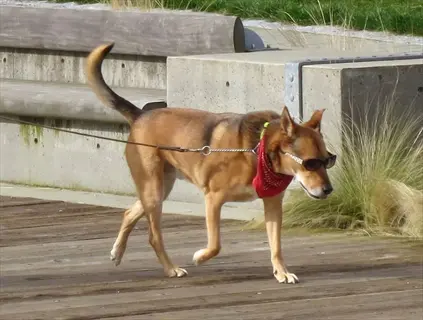
Front-Clip Harnesses
- Front-clip harnesses effectively redirect dogs toward handlers when tension occurs, discouraging pulling behavior during initial training sessions with consistent results
- Ideal for strong pullers and large breeds requiring gentle control mechanisms that maintain natural movement patterns without restrictive pressure points
- Proper fit requires allowing two fingers between harness material and dog's body, ensuring comfort during extended walks in various weather conditions
- Padded chest plates distribute pressure evenly across the sternum area, preventing chafing or discomfort during active outdoor adventures with energetic dogs
- Adjustable straps accommodate growing puppies and allow seasonal adjustments for thicker winter coats without compromising security or comfort levels
- D-ring placement at the chest provides optimal control leverage when redirecting enthusiastic dogs away from distractions during challenging training scenarios
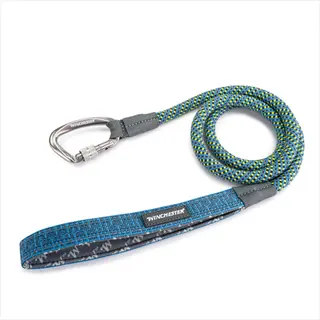
Standard Leashes
- Six-foot nylon leashes provide optimal control length for neighborhood walks while maintaining close communication during essential training moments
- Avoid retractable leashes which encourage pulling behaviors and offer reduced responsiveness during critical moments requiring immediate intervention
- Leather options develop suppleness over time but require monthly conditioning to prevent cracking in dry climates with humidity below forty percent
- Double-stitched stress points withstand sudden pulls from large breeds without compromising structural integrity under forces exceeding one hundred pounds
- Traffic handles near the clip provide emergency grip points when navigating busy streets with vehicle traffic moving at thirty miles per hour
- Reflective stitching enhances visibility during dawn and dusk walks when low-light conditions reduce human visual perception capabilities significantly

Flat Collars
- Well-fitted collars should allow two fingers between neck and material without slipping over ears during vigorous movement or playful activities
- Suitable for dogs with established leash manners needing minimal correction during routine neighborhood walks covering several miles weekly
- Metal buckles withstand greater force than plastic closures for energetic breeds prone to sudden lunging at speeds exceeding fifteen feet per second
- Quick-release buckles allow emergency removal within two seconds if collars become caught on fences or other environmental hazards unexpectedly
- Personalized identification tags provide critical contact information if dogs accidentally escape during walks in unfamiliar territory locations
- Martingale designs prevent escape artists from backing out while maintaining constant pressure distribution across the entire neck circumference

Training Treat Pouches
- Waist-worn pouches with waterproof lining keep high-value rewards accessible during critical training moments requiring immediate positive reinforcement
- Multi-compartment designs allow separation of different treat types for varied reinforcement strategies adapting to diverse training scenarios
- Magnetic closures enable rapid access while preventing accidental spillage during active training sessions with multiple reward delivery requirements
- Belt clips distribute weight evenly around hips rather than straining shoulders during extended practice sessions lasting over thirty minutes
- Insulated pockets maintain treat freshness during summer months when temperatures exceed eighty degrees Fahrenheit causing rapid spoilage issues
- Audible closure mechanisms help handlers locate pouches quickly without visual confirmation during low-light conditions at dawn or dusk
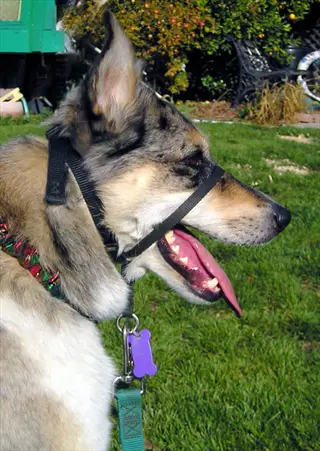
Head Halters
- Head halters offer gentle steering control by guiding the muzzle direction, similar to horse bridle principles adapted for canine companions of all sizes
- Require gradual acclimation through positive reinforcement techniques to prevent dogs from pawing at unfamiliar equipment during initial introduction phases
- Proper fit ensures the nose loop sits comfortably behind whiskers without restricting panting or drinking abilities during warm weather exercise sessions
- Back strap should sit high on the neck without sliding toward shoulder blades during movement or sudden pulls exceeding fifty pounds of force
- Ideal for reactive dogs needing precise directional control near high-distraction environments like crowded parks with numerous unpredictable stimuli
- Safety release mechanisms allow quick removal within seconds if the halter becomes caught on environmental obstacles during outdoor adventures
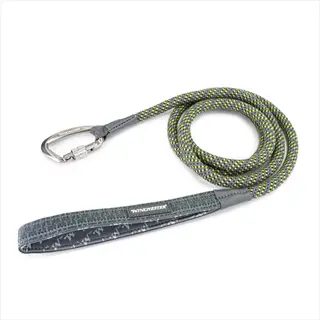
Long Training Lines
- Twenty to thirty-foot lines provide controlled freedom for recall practice in open spaces while maintaining handler oversight capabilities throughout
- Lightweight biothane material floats on water and resists dirt accumulation during outdoor training sessions across various terrain types and conditions
- Gradual length progression allows dogs to build reliable recall before transitioning to off-leash privileges in designated safe areas only
- Glove-friendly handles prevent rope burns during sudden sprints while maintaining secure grip in wet conditions with rainfall exceeding one inch hourly
- Bright colors increase handler visibility when managing multiple dogs simultaneously in group training scenarios with numerous participants present
- Proper coiling techniques prevent dangerous tangling around legs or environmental obstacles during active movement across diverse landscapes
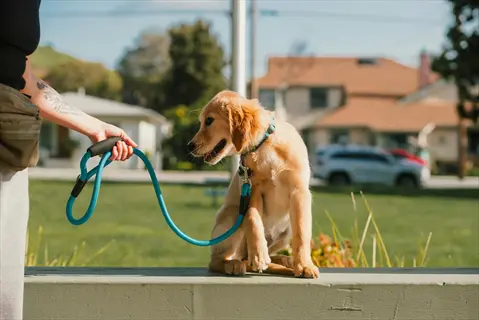
Hands-Free Waist Belts
- Waist-mounted leash attachments distribute pulling force to core muscles instead of straining arm joints during extended walking sessions
- Shock-absorbing bungee sections reduce sudden jolts when dogs lunge unexpectedly toward distractions with forces exceeding fifty pounds
- Adjustable webbing accommodates various body sizes while maintaining comfortable positioning during movement across several miles of terrain
- Multiple attachment points allow tandem walking with multiple dogs without dangerous tangling issues during complex training exercises
- Padded lumbar support prevents lower back strain during extended hiking or jogging sessions covering distances over five miles regularly
- Quick-release buckles enable rapid detachment during emergencies requiring immediate separation within fractions of a second response time
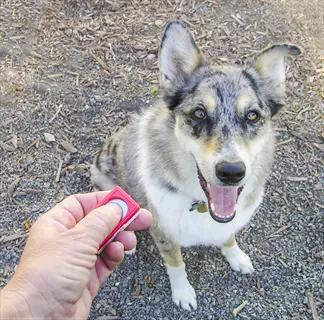
Training Clickers
- Audible markers create precise communication timing for rewarding desired leash-walking behaviors with consistent auditory signals dogs recognize
- Consistent sound becomes a conditioned reinforcer signaling imminent food rewards during training sequences repeated multiple times daily
- Wrist straps prevent accidental drops while maintaining immediate accessibility during critical moments requiring split-second timing accuracy
- Variable volume settings accommodate different environments from quiet homes to noisy urban streets with ambient sounds exceeding seventy decibels
- Ergonomic designs ensure comfortable operation for handlers with arthritis or limited hand mobility during extended training sessions
- Distinctive sounds avoid confusion with environmental noises that might distract sensitive dogs during complex outdoor training scenarios
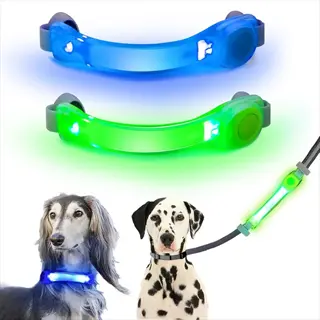
LED Safety Lights
- Clip-on lights increase visibility during low-light conditions like dawn, dusk, or nighttime walks when visibility drops below twenty feet
- Multiple light modes include steady beams for constant visibility and blinking patterns for attention-grabbing alerts to approaching vehicles
- Weather-resistant casings withstand rain and snow exposure without compromising functionality during storms with rainfall exceeding one inch
- Rechargeable batteries eliminate frequent battery replacement costs while reducing environmental waste over years of regular usage patterns
- Universal attachment systems work seamlessly with various collar, harness, and leash hardware types regardless of manufacturer specifications
- Adjustable brightness settings prevent overwhelming light-sensitive dogs while ensuring human visibility at distances exceeding one hundred feet
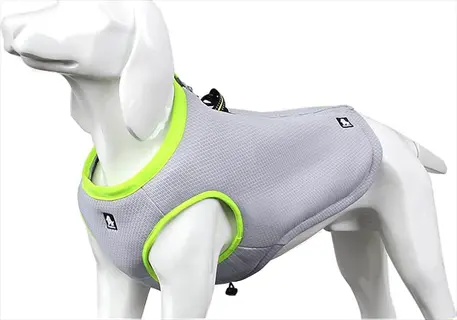
Cooling Harness Inserts
- Phase-change material inserts regulate body temperature during hot weather training sessions when ambient temperatures exceed eighty degrees
- Activation requires twenty minutes of refrigeration before providing extended cooling relief lasting approximately two hours during outdoor activities
- Moisture-wicking fabrics prevent chafing while promoting airflow across pressure points during exercise sessions exceeding thirty minutes duration
- Non-toxic gel formulations ensure safety if curious puppies chew through protective outer layers during unsupervised exploration moments
- Removable designs allow seasonal adaptation to changing temperature conditions throughout the year without requiring multiple harness purchases
- Lightweight construction avoids adding significant bulk or weight that might hinder movement during agility training or fast-paced activities
Dog Size Considerations
- Small breeds benefit from lightweight harnesses distributing pressure across the chest rather than delicate tracheas vulnerable to injury
- Medium dogs often transition from front-clip to back-clip harnesses as leash skills improve over several weeks of consistent training
- Large breeds require sturdy hardware capable of withstanding sudden pulls exceeding one hundred pounds of force during unexpected events
Material Durability
- Nylon webbing withstands frequent washing but may fray after prolonged exposure to abrasive surfaces like concrete or rocky terrain
- Leather develops protective patina over time but requires monthly conditioning to prevent drying and cracking in humidity below forty percent
- Metal hardware must feature rust-resistant coatings for reliable performance in all weather conditions including heavy rain and snow
Comfort Features
- Padded straps prevent chafing and hair loss during extended training sessions exceeding thirty minutes in various weather conditions
- Breathable mesh panels facilitate airflow to reduce overheating risks in temperatures above seventy degrees Fahrenheit during summer months
- Adjustable points ensure customized fit adaptation as dogs grow or experience seasonal weight changes exceeding ten percent body mass
Safety Mechanisms
- Quick-release buckles allow emergency equipment removal within two seconds if tangled in bushes or fencing during exploratory walks
- Reflective stitching enhances visibility to vehicles during low-light conditions when accident risks increase significantly after sunset
- Identification tag rings must accommodate engraved contact information with clearly readable lettering visible at distances of three feet
Handler Convenience
- Waist attachments distribute leash pressure to stronger hip muscles rather than straining arm joints during walks exceeding one mile
- Treat pouches with magnetic closures enable single-handed operation without visual confirmation needs during complex training exercises
- Leash loops provide multiple grip positions accommodating different handler heights varying by over twelve inches in stature differences
Core Leash Skills Foundation
Start with marker training inside when distractions aren't a problem. You want to be sure to use a clicker or verbal marker, like "Yes," to mark desired behavior immediately. Practice this for a while until it's going well, and then move outside. Gradually acclimate your dog to the new outside settings when you know they are responding well in the house.
Grasp the difference between food fatigue vs leash pressure techniques. Food lures are a technique that guides the dog's movement with food rewards (e.g., treats). In contrast, leash pressure conveys cues to the dog in the form of gentle tension and is used to signal direction. Food is used to teach new behaviors/skills in the beginning, then leash pressure is used for refinement as the dog progresses.
Embrace the 3-second rule in reward timing to capture effective behavior. Give treats immediately after marking correct responses. This exact timing teaches your dog to associate behavior directly with the reward. With continued practice, responses can be consistently counted on, even in the face of distractions.
Overcome breed-specific focus limitations by altering your training methods when necessary. For example, herding breeds need lots of movement exercise, while sighthounds need lots of extra sniff time. Sporting dogs can derive numerous benefits from retrieval exercises during training sessions. Utilize the dog's instincts to modify the training for a positive outcome.
Marker Conditioning
- Associate audible markers like clickers or verbal 'yes' with imminent food rewards during stationary exercises
- Practice timing consistency by marking desired behaviors within one second of occurrence
- Gradually increase distraction levels from silent rooms to outdoor environments
- Use variable reward schedules to maintain engagement during repetitive training sessions
- Transition markers to leash skills by clicking during loose-leash walking moments
Leash Pressure Desensitization
- Attach leash indoors without tension, rewarding calm behavior with high-value chicken treats
- Apply gentle pressure in four directions (forward/back/left/right), marking compliance immediately
- Increase pressure intensity gradually over multiple sessions as tolerance builds
- Measure progress by reduced reaction time to pressure releases below two seconds
- Incorporate directional cues like 'let's go' during forward pressure applications
Follow Exercises
- Use backward walking to encourage natural following instincts without verbal commands
- Reward position maintenance within three feet using treat delivery at knee height
- Vary walking speed and direction changes to build engagement and responsiveness
- Extend duration gradually from ten seconds to two minutes of continuous following
- Add environmental challenges like scattered treats at five-foot intervals
Cue Association
- Introduce 'let's go' before forward movement during low-distraction indoor sessions
- Pair 'this way' with ninety-degree turns after five successful straight-line repetitions
- Use 'wait' for temporary stops, gradually increasing duration from three to thirty seconds
- Practice cue generalization across different locations and surface types
- Add hand signals to reinforce verbal commands for hearing-impaired dogs
Distraction Proofing
- Begin with mild distractions like dropped treats at ten-foot distances
- Progress to moderate challenges like toy tossing during straight-line walking
- Introduce high-level distractions such as doorbell sounds at seventy decibels
- Use controlled exposure to common triggers like passing cars at twenty mph speeds
- Implement distance management by starting thirty feet from distractions
Mastering Loose Leash Walking
Implement the stop-and-wait technique for persistent pullers by completely freezing when tension occurs. Remain in this position until the leash has naturally returned to slack again. Reward only when the dog has happily returned to your side. This teaches that pulling stops progress, but that cooperation continues for walks.
Control speed with the circle style, steering the leash in wide portions when the dog gets up. Give a full two circles with soft leash pressure. For the dog's excellent attention at the finish of the circle, give a reward. Decrease the circles in size as the desired effect is obtained, until the dog becomes able to match the pace plainly and distinctively without hysteria.
Develop the best verbal cue timing by encouraging the cue, "this way," approximately one second before momentum changes direction. Reward with IMMEDIATE reward up to three seconds maximum after notice of response. Practice varied patterns, such as zigzags and figure eights. Consistent cue delivery leads to predictable communication that your dog understands, even in the presence of distractions.
Utilize scatter feeding in trigger settings by scattering treats before a reaction can start. This initial stage requires a distance of approximately twenty feet from potential distractions (such as other dogs, squirrels, etc.) by using ground scatter delivery, which promotes the calming exercise of sniffing. Begin decreasing the distance gradually as your dog learns to capitalize on rewards instead of focusing on triggers.
Stop and Wait
- Freeze immediately when leash tension exceeds two pounds (0.9 kg) of pressure
- Maintain stationary position until dog returns voluntarily within ten seconds
- Reward with high-value treats only after slack leash position is achieved
- Gradually increase environmental distractions from quiet rooms to busy streets
- Measure progress by reduced response time below five seconds after three weeks
Circle Around
- Initiate wide circles when pulling begins, covering ten to fifteen feet (3-4.5 m) diameter
- Maintain gentle leash guidance without jerking motions during direction change
- Reward engagement after completing two full rotations with focused attention
- Gradually decrease circle size as responsiveness improves over multiple sessions
- Combine with treat scatters at completion point to reinforce calm behavior
Back Up
- Retreat five to eight steps (4-6 ft/1.2-1.8 m) when dog surges ahead of knee position
- Encourage following behavior using enthusiastic vocal encouragement
- Deliver rewards at hip level to maintain ideal heel position orientation
- Increase retreat distance gradually from three to twelve feet (0.9-3.7 m) over time
- Vary retreat speed from slow backwards steps to brisk reverse walking
Change Direction
- Execute ninety-degree turns when attention drifts from handler position
- Use clear verbal cue 'this way' one second before directional change
- Reward immediate reorientation within three seconds of command initiation
- Practice in patterns: zigzags, figure eights, and random angle variations
- Increase unpredictability by changing pace during turns after mastery
Verbal Cues
- Introduce 'let's go' before forward movement after successful halts
- Pair 'with me' command with treat delivery at ideal heel position
- Practice cue consistency across different environments and times of day
- Phase out food lures gradually after twenty successful repetitions
- Add hand signals pointing downward for hearing-impaired dogs
Reward Calmness
- Mark and treat spontaneous slack-leash moments within two seconds
- Use variable reinforcement: reward every 3-7 steps of loose walking
- Gradually increase distance between rewards from three to twenty feet (0.9-6 m)
- Incorporate environmental rewards like sniffing breaks after compliance
- Track progress using session notes documenting duration between rewards
Scatter Feeding
- Toss ten to fifteen small treats when approaching high-distraction zones
- Use ground-level delivery to encourage nose-down calming posture
- Begin implementation twenty feet (6 m) before reaching trigger points
- Gradually reduce treat quantity as emotional response diminishes
- Measure success by reduced reaction distance from thirty to ten feet (9-3 m)
1-2-3 Game
- Count aloud 'one-two-three' while taking three steps with loose leash
- Deliver reward after third step if tension remains below one pound (0.45 kg)
- Gradually increase step count from three to ten before rewarding
- Vary reward location: hand delivery vs. ground tosses to maintain engagement
- Use in high-distraction areas after mastering in low-stimulus environments
Troubleshooting Challenges
Address pulling versus lunging behavior with two different targeted strategies. For pulling behavior, use stop-and-wait techniques to stop the movement completely. For lunging behavior, back away immediately and then redirect towards scattering feeding. These distinct behaviors recognize the different behavioral challenges, therefore require different solutions for effective resolution.
Hand exercises allow for more exercise for high-energy breeds. Border collies and huskies require twenty minutes of fetch before leash training. This will reduce hyped-up energy that causes the dog to pull. Structured play, such as flirt pole work, can fulfill their natural drive for productivity.
Identify the reactive dog's threshold distances. Find and train from points of triggers. Start training at a distance of approximately thirty feet away from things that trigger the dog's reaction. Gradually decrease the distance, but only if the dog is calm. This distance is a safe zone to prevent the dog from being overwhelmed and a place to build confidence through exposure.
Utilize regression recovery protocols in the event of a skills backslide. For three sessions in a row, take the dog back to the original foundation exercises. Utilize a higher-value motivator, such as chicken, to reinstate motivation. Keep the sessions brief to boost confidence without getting frustrated in the process.
Persistent Pulling
- Assess underlying causes: insufficient exercise or improper equipment fit
- Implement front-clip harness with combined stop-wait technique
- Measure progress by reduced tension below two pounds (0.9 kg) of pressure
- Increase pre-walk exercise for high-energy breeds by fifteen minutes minimum
- Transition to verbal cues only after three weeks of consistent improvement
Distraction Lunging
- Identify trigger distance where reactions begin (typically 20-30 ft/6-9 m)
- Implement scatter feeding at threshold distance before reactions occur
- Gradually decrease distance by three feet (0.9 m) per successful session
- Use U-turns to create space when triggers appear unexpectedly
- Record reaction intensity weekly to measure desensitization progress
Excessive Barking
- Address root causes: frustration, fear, or insufficient mental stimulation
- Implement focus games like treat searches during triggering events
- Increase daily enrichment: food puzzles for thirty minutes minimum
- Use distance management by maintaining fifty-foot (15 m) buffers from triggers
- Track barking duration reduction from baseline measurements
Regression Episodes
- Identify triggers: schedule changes, unfamiliar environments, or health issues
- Revert to foundational training for three consecutive sessions minimum
- Reduce session duration to five minutes to rebuild confidence gradually
- Increase reward value using special treats reserved for regression recovery
- Maintain training journal documenting patterns and successful interventions
Equipment Resistance
- Counter-condition gear introduction using high-value chicken treats
- Practice fifteen-second wear intervals before walks, gradually increasing
- Assess fit issues causing discomfort using two-finger rule checks
- Transition to alternative gear style if aversion persists beyond two weeks
- Monitor body language: shaking or avoidance indicates need for professional help
Barking During Walks
- Identify triggers: other dogs, unfamiliar people, or environmental sounds
- Implement quiet command training using positive interruption techniques
- Use desensitization by recording triggers and playing at low volumes at home
- Practice focus exercises before walks to establish handler attention priority
- Measure progress by counting reduced barking incidents per walk
5 Common Myths
Leash pulling indicates a dog is trying to take control of the owner, requiring harsh corrections to establish dominance over the dog.
Leash pulling is really an instinct to explore and the dog has not been properly trained, not a dominance problem. Harsh corrections will lead to fear responses and harm the bond of trust between dog and handler. Positive reinforcement is needed for good, reliable loose leash walking, rewarding positive behavior consistently. Training techniques based on relationships give better longlasting results and a better bond, without psychological trauma or anxiety problems while walking.
Older dogs cannot learn good leash manners. They are set in their ways and resistant to doing new things.
Dogs of all ages are still capable of learning because of the property of neuroplasticity. Therefore, older dogs can learn to walk nicely on a leash if the right techniques are used. It may take longer periods of lessons of shorter duration, but older dogs are very proficient at learning via constant positive reinforcement. This is due to their improved ability to concentrate and control their impulses. The senior dog will learn so quickly that he will demonstrate a better learning ability than the puppy. The older dog uses this ability he has developed with age to learn better. Such things as high valued foods help the senior dog over come habitacies without stress and confusion to him in the learning process.
Retractable leads offer dogs greater freedom and safety while walking than standard six-foot (1.8 M) leads.
Retractable leads result in pulling behaviors because the tension is rewarded by the leash lengthening, and consistency in training is broken. The thin cords of the lead can inflict extremely painful friction burns on the skin and will break under the strain, when being pulled by a large strong dog. Standard six-foot (1.8 M) leads afford greater emergency control and promote clearer communication during walks. Fixed length leads prevent accidents occuring by entanglement around obstacles, or inter-dog entanglement in public areas.
Punishment-based instruments such as choke chains and prong collars are necessary to train strong-minded large breed dogs effectively.
Modern positive reinforcement techniques yield superior results without physical discomfort or psychological distress. Front-clip harnesses afford gentle control for the powerful breeds while reward-led techniques develop willing compliance. The use of aversive devices increases the stress response to training and the potential for aggression. Structuration of the training game result in dependable off-leash responsiveness through trust not fear corrections with the dog of all sizes and temperaments.
Walks are for physical exercise only and provide very little mental stimulation or training opportunities for dogs.
Walks with structure offer vital mental stimulation through environmental challenges and problem solving activities. Sniffing activities during walks relieve stress more effectively than physical exercise alone, plus they satisfy natural dog instincts. Integrating training games with walks can turn routine walks into cognitive workouts which help prevent behavior problems like anxiety or destructiveness. And the mental stimulation from varied routes and challenges will often tire dogs completely more than pure physical effort will.
Conclusion
Regular leash training changes chaotic walks into calm bonding experiences. The journey builds trust through open communication and positive reinforcement techniques. The changes reflect on all aspects of your relationship with your dog, not just leash training. By making small efforts every day, the results last a long time and are well worth celebrating.
During training, *relationships over perfection.* Look for small victories like shorter pulling distances or quicker responses. Progress is the goal, not perfection! My lab mix looks at squirrels, but now, instead of doing an "out" or chasing them, looks back immediately, all because of this approach.
Enjoy additional benefits beyond walking improvement such as better recall and impulse control. These skills translate into vet visits, grooming visits, and social events. Your dog will be more relaxed in different situations, making everyday life easier for both of you.
Start using these techniques today on your next walk. Choose one method, such as stop-wait or scatter feeding, and practice. Change begins with that first purposeful step forward together. Your walks to hold less pulling, more connection.
External Sources
Frequently Asked Questions
What is the fastest way to leash train a dog?
The most effective approach combines front-clip harnesses with consistent positive reinforcement techniques. Immediately reward loose-leash moments using high-value treats during short daily sessions. Incorporate stop-wait methods when tension occurs to discourage pulling without force or punishment.
How do I stop my dog from pulling on the leash?
Use these proven techniques:
- Implement the stop-wait method: Freeze when tension exceeds 2 lbs until slack returns
- Practice direction changes to maintain engagement
- Use scatter feeding near distractions to refocus attention
- Gradually increase challenge levels as skills improve
Is it too late to leash train an older dog?
Dogs of any age can successfully learn leash manners through consistent positive reinforcement. While older dogs may require more patience to overcome established habits, their improved focus often accelerates training compared to puppies when using appropriate techniques.
What equipment works best for leash training?
Essential equipment includes:
- Front-clip harnesses for gentle steering control
- Six-foot fixed-length leashes for clear communication
- Waist treat pouches for immediate reinforcement access
- Properly fitted collars using the two-finger rule
- Head halters for strong pullers needing precise guidance
How long does leash training take?
Most dogs show significant improvement within 3-6 weeks of consistent daily practice. Complex cases involving severe pulling or reactivity may require 2-3 months. Progress depends on consistency, proper technique application, and gradually increasing environmental challenges during sessions.
Should dogs meet while on leash?
Leash greetings often create tension since restricted movement prevents natural canine communication. This forced interaction frequently triggers defensive reactions. Instead, introduce dogs in neutral off-leash areas where they can maintain appropriate distance and body language signals.
Is sniffing allowed during leash training?
Controlled sniffing provides crucial mental stimulation when incorporated strategically:
- Designate specific sniff zones using release cues
- Allow exploration after compliance with commands
- Limit duration to maintain training focus
- Use sniffing as a reward for loose-leash walking
What are essential leash training commands?
Key commands include:
- "Let's go" for forward movement initiation
- "This way" for directional changes
- "Wait" for temporary stops
- "Focus" for attention redirection
- "Easy" for pace reduction
Are training treats necessary for leash training?
High-value treats provide immediate positive reinforcement for desired behaviors like loose-leash walking. Gradually phase them out after consistent compliance by replacing with:
- Verbal praise and petting
- Environmental rewards like sniffing breaks
- Play opportunities after successful walks
- Variable reinforcement schedules
How long should leash training sessions last?
Ideal sessions range from 5-15 minutes based on the dog's focus capacity. End before frustration or fatigue sets in. Multiple short sessions daily yield better results than infrequent marathon sessions. Gradually increase duration as attention span improves over weeks.

